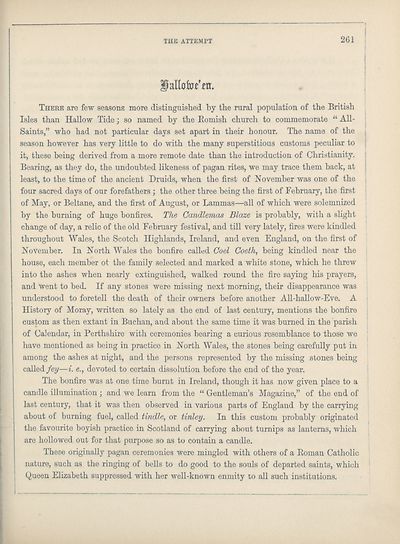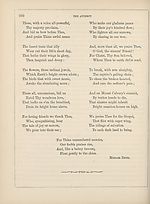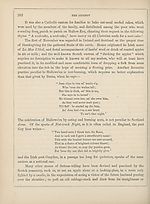Attempt > Volume 1 and Select writings
(273) Page 261
Download files
Complete book:
Individual page:
Thumbnail gallery: Grid view | List view

I
THE ATTEMPT 261
faKofo^n.
There are few seasons more distinguished by the rural population of the British
Isles than Hallow Tide; so named by the Eomish church to commemorate “ All-
Saints,” who had not particular days set apart in their honour. The name of the
season however has very little to do with the many superstitious customs peculiar to
it, these being derived from a more remote date than the introduction of Christianity.
Bearing, as they do, the undoubted likeness of pagan rites, we may trace them back, at
least, to the time of the ancient Druids, when the first of November was one of the
four sacred days of our forefathers ; the other three being the first of February, the first
of May, or Beltane, and the first of August, or Lammas—all of which were solemnized
by the burning of huge bonfires. The Candlemas Blaze is probably, with a slight
change of day, a relic of the old February festival, and till very lately, fires were kindled
throughout Wales, the Scotch Highlands, Ireland, and even England, on the first of
November. In North Wales the bonfire called Coel Coeth, being kindled near the
house, each member ot the family selected and marked a white stone, which he threw
into the ashes when nearly extinguished, walked round the fire saying his prayers,
and went to bed. If any stones were missing next morning, their disappearance was
understood to foretell the death of their owners before another All-hallow-Eve. A
History of Moray, written so lately as the end of last century, mentions the bonfire
custom as then extant in Buchan, and about the same time it was burned in the parish
of Calendar, in Perthshire with ceremonies bearing a curious resemblance to those we
have mentioned as being in practice in North Wales, the stones being carefully put in
among the ashes at night, and the persons represented by the missing stones being
called fey—i. e., devoted to certain dissolution before the end of the year.
The bonfire was at one time burnt in Ireland, though it has now given place to a
candle illumination ; and we learn from the “ Gentleman’s Magazine,” of the end of
last century, that it was then observed in various parts of England by the carrying
about of burning fuel, called tindle, or tinley. In this custom probably originated
the favourite boyish practice in Scotland of carrying about turnips as lanterns, which
are hollowed out for that purpose so as to contain a candle.
These originally pagan ceremonies were mingled with others of a Roman Catholic
nature, such as the ringing of bells to do good to the souls of departed saints, which
Queen Elizabeth suppressed with her well-known enmity to all such institutions.
THE ATTEMPT 261
faKofo^n.
There are few seasons more distinguished by the rural population of the British
Isles than Hallow Tide; so named by the Eomish church to commemorate “ All-
Saints,” who had not particular days set apart in their honour. The name of the
season however has very little to do with the many superstitious customs peculiar to
it, these being derived from a more remote date than the introduction of Christianity.
Bearing, as they do, the undoubted likeness of pagan rites, we may trace them back, at
least, to the time of the ancient Druids, when the first of November was one of the
four sacred days of our forefathers ; the other three being the first of February, the first
of May, or Beltane, and the first of August, or Lammas—all of which were solemnized
by the burning of huge bonfires. The Candlemas Blaze is probably, with a slight
change of day, a relic of the old February festival, and till very lately, fires were kindled
throughout Wales, the Scotch Highlands, Ireland, and even England, on the first of
November. In North Wales the bonfire called Coel Coeth, being kindled near the
house, each member ot the family selected and marked a white stone, which he threw
into the ashes when nearly extinguished, walked round the fire saying his prayers,
and went to bed. If any stones were missing next morning, their disappearance was
understood to foretell the death of their owners before another All-hallow-Eve. A
History of Moray, written so lately as the end of last century, mentions the bonfire
custom as then extant in Buchan, and about the same time it was burned in the parish
of Calendar, in Perthshire with ceremonies bearing a curious resemblance to those we
have mentioned as being in practice in North Wales, the stones being carefully put in
among the ashes at night, and the persons represented by the missing stones being
called fey—i. e., devoted to certain dissolution before the end of the year.
The bonfire was at one time burnt in Ireland, though it has now given place to a
candle illumination ; and we learn from the “ Gentleman’s Magazine,” of the end of
last century, that it was then observed in various parts of England by the carrying
about of burning fuel, called tindle, or tinley. In this custom probably originated
the favourite boyish practice in Scotland of carrying about turnips as lanterns, which
are hollowed out for that purpose so as to contain a candle.
These originally pagan ceremonies were mingled with others of a Roman Catholic
nature, such as the ringing of bells to do good to the souls of departed saints, which
Queen Elizabeth suppressed with her well-known enmity to all such institutions.
Set display mode to: Large image | Transcription
Images and transcriptions on this page, including medium image downloads, may be used under the Creative Commons Attribution 4.0 International Licence unless otherwise stated. ![]()
| Ladies' Edinburgh Debating Society publications > Attempt > Volume 1 and Select writings > (273) Page 261 |
|---|
| Permanent URL | https://digital.nls.uk/109868230 |
|---|
| Attribution and copyright: |
|
|---|

